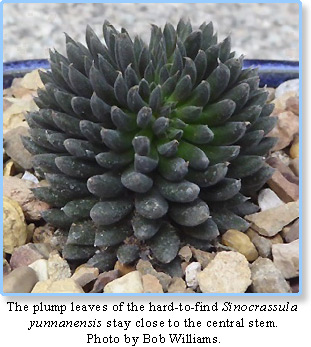Sinocrassula yunnanensis (2018)
By Bob Williams (August 2018)
 The annual show and sale is complete. It is always a hectic four days, and the plants are amazing, both the display and the sale plants.
The annual show and sale is complete. It is always a hectic four days, and the plants are amazing, both the display and the sale plants.
Even though I say I am at capacity in my house, I always seem to bring a few more plants home from the sale. It seems like I always hear a plant or two calling out, “Buy me, buy me.” One called out louder than most this year. A member brought in some seedlings of a crested version of Sinocrassula yunnanensis.
These are interesting plants. When talking to the seller, he mentioned that you don’t find them for sale much in the United States. That seems like a challenge for an article, so here it is.
As the name implies, the genus Sinocrassula is a member of the Crassulaceae family. The Crassulaceae family has a large number of members. Some of the more familiar members are Aeonium, Cotyledon, Crassula, Dudleya, Echeveria, Kalanchoe, Sedum and Tylecodon. The common denominator for these plants is that they have succulent leaves.
They are found throughout the world. Many are common houseplants, and many are used in landscaping. In my research, there is no record that these plants are used for food or medicinal purposes. One of the most recognized species of the Crassulaceae family is the jade plant.
The name sinocrassula translates to “Chinese crassula” and should give you a clue to where the plants are found: the southeastern region of China and surrounding areas. Its general area includes Bhutan, Nepal, northeast India, Pakistan and China.
In 2012, a new species was discovered in northern Vietnam, bringing the total number of species in the genus to eight. The species with the widest distribution is Sinocrassula indica, which is found in most of the regions listed above. The other six species are found in the Yunnan and Sichuan regions of China.
Plants in Sinocrassula are sometimes referred to as “mini jade” or “Chinese jade.” These nicknames refer more to the leaf structure than the overall plant.
The plants grow to a height of 10 inches or so. They do not form a trunk like the common jade plant, but tend to clump and grow in a rosette pattern. These clumps can expand and fill a large area, similar to the growth of a sedum or echeveria. The leaves are relatively small and succulent, and do not grow more than 1 inch out from the rosette. They tend to be rounded on the top of the leaf and flat on the bottom.
Sinocrassulas grow on rocky mountainsides in gravel and can be found in cracks in rocks that have good drainage. They can be found at elevations from 700 to 3,700 meters.
 The flowers are large for the size of the plants, which flower in autumn or early winter. The leaves are loosely attached and will root and grow new plants. These plantlets often become “weeds” in nearby pots. In this respect, they resemble kalenchoes.
The flowers are large for the size of the plants, which flower in autumn or early winter. The leaves are loosely attached and will root and grow new plants. These plantlets often become “weeds” in nearby pots. In this respect, they resemble kalenchoes.
Sinocrassula yunnanensis is native to the Yunnan Province in southwestern China and grows in well-draining, rocky areas from 2,500 to 2,800 meters elevation. It is the best-known species of this genus.
These plants like plenty of light and can tolerate full sun, but can grow well in bright, indirect light. S. yunnanensis prefers dry conditions, and it is best to refrain from watering it until the root ball has dried out completely. The plant can then be immersed in water, removed and left until it has completely dried out again. Its succulent leaves will store enough water to survive for a long time.
Sinocrassula yunnanensis can be grown outdoors in the rock crevices of a rock garden, but it is not winter-hardy in our area. This is a tough plant that spreads aggressively by dropped leaves, seed, cuttings or division of the rosettes.
The plant is monocarpic, so the individual rosettes bloom only once, then die, replaced by nearby clumps. The crested variations can be propagated only by cuttings from the crested parts.
Sinocrassulas are not readily available in the United States, but are popular in Japan and other parts of Asia. Listings on eBay show that very few growers in Europe offer the plants for sale.
Sources:
Llifle Encyclopedia of Succulents – http://llifle.com/Encyclopedia/SUCCULENTS/Family/Crassulaceae/19295/Sinocrassula_yunnanensis
Sinocrassula vietnamenis (Crassulaceae), New Species and New Generic Record in the Flora of Vietnam – https://www.researchgate.net/publication/287053621_Sinocrassula_vietnamenis_Crassulaceae_New_Species_and_New_Generic_Record_in_the_Flora_of_Vietnam
The Plant List – http://www.theplantlist.org/tpl/search?q=sinocrassula
Revolvy – https://www.revolvy.com/topic/Sinocrassula&item_type=topic
International Crassulaceae Network – http://www.crassulaceae.ch/de/artikel?akID=322
